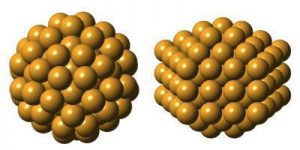Composites: An interesting set of articles have appeared on composite metal foams. Research conducted at North Carolina State University (NCSU) by Professor Afsaneh Rabiei [Ref. 1] has developed a material with sufficient properties to stop an armor piercing bullet. The national Institute of Justice specification is that a bullet be stopped with an indentation of less than 44 mm at the back of the armor. This particular CMF under an inch thick can stop the bullet with less than an 8 mm indentation at the back.
Metal foams are materials that can be produced by pumping gas through molten metal as it cools. Cornell University has a different process that places foam into molten metal in a vacuum, where the foam fills the pores within the metal structure. This material is composed of a soft alloy with a porous silicone foam. The resultant material is lead free, which opens up many different applications.
The properties of the NCSU composite material is very light weight and appears to have the potential for being employed in nuclear waste storage, since it has some radiation absorbing properties.
Transistors: Applications of graphene transistors have been increasing. A Japanese research team at Japan’s National Institute for Materials Science designed a graphene field-effect transistor (GFET) consisting of titanium-gold electrons on a single layer graphene deposited in a silicon substrate. [Ref. 2] The “GFETs can detect harmful genes through DNA hybridization, which occurs when a ‘probe DNA’ combines, of hybridizes, with its complementary ‘target DNA’ Electrical conduction changes in the transistor when hybridization occurs.”
The current procedure detects the DNA hybridization through a labeling of the target with a fluorescent dye, which will shine brightly when it combines with its probe. This is a complicated and expensive procedure, which also requires expensive laser scanners to detect the fluorescence. The researchers look to the development of biosensor applications that are focused on genetic disease detection.
Better Magnets through observing Graphene: A system of tri-layer graphene has been has been developed that allows observations of electronic interactions within the three layers of graphene. [Ref. 3] Their work sheds light on magnetism of electrons in three layers of graphene at -272 Celsius and occurs from coordinated weak interactions among many electrons. Their explanation is that metals have a large density of electrons. Observing the wave nature of elections requires a metal wire of a few atoms wide. The scattering of atoms occurs in 100nm or less. Graphene, which has a smaller density of electrons can travel up to 10 microns before scattering. Observing electrons in graphene between layers for boron nitride provides the ability to observe the electron interactions and the faint “whispers” (as the researchers call it) of electrons interacting with each other. Understand the interactions will enable the construction of materials with greater interactions. While they are not projecting future efforts, it is very possible that the understanding of the interaction could lead to the properties required for a material to be a room temperature super conductor.
The developments based on increased understanding of material properties at the nano level can lead to very promising developments in novel material properties. Stay tuned for more developments in 2017.
References:

